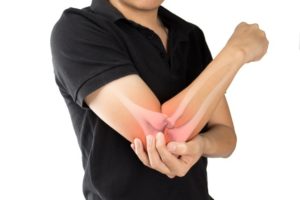So What is it? How do you get it? What can you do to heal as quickly as possible from it?
One of the most common injuries I see as a trainer is tendonitis. So, what is it? How do you get it? What can you do to heal as quickly as possible from it?
Tendonitis is a condition [1] where the connective tissues between your muscles and bones (tendons) become inflamed. Often caused by repetitive activities, tendonitis can be painful. It commonly happens in the elbow, knee, shoulder, hip, Achilles tendon and base of the thumb. In my experience whenever I have gotten it. It was in my elbow. And I felt a distinct burning sensation in my joint.

Common areas that you find tendonitis [2] are:
Shoulder. The most common form of tendonitis in the shoulder is rotator cuff tendonitis. It involves the tendon of the supraspinatus muscle, which attaches to the upper portion of the upper arm bone at the shoulder joint. Again, the injury usually occurs from overuse, typically in an occupation or sport that requires the arm to be elevated repeatedly. Jobs and activities where tendonitis is common include carpenters, painters, welders, swimmers, tennis players, and baseball players. I train a few people who really enjoy swimming on a regular basis and have for many, many years. They will come into the gym on a regular basis complaining about their shoulders aching. I know they really enjoy swimming so I don’t want to discourage the activity but I have often wondered that since they are in water and in a lot of ways in a weight-less state if they think that the water is a “no-injury” zone.
Elbow. Two forms of tendonitis commonly involve the elbow.
Lateral epicondylitis (tennis elbow) causes pain on the outer side of the elbow joint. This condition probably affects 40% to 50% of all adult athletes who play racquet sports. It also can be caused by any activity that repeatedly twists and flexes the wrist, such as pulling weeds, using a screwdriver or even carrying a briefcase.
Medial epicondylitis (golfer’s elbow) causes pain on the inner side of the elbow. Despite its name, it is more likely to be related an occupation that requires repeated elbow movements, such as construction work, than to sports. When it does occur as a sports injury, medial epicondylitis can be triggered by repeatedly swinging a golf club or throwing a baseball.
Knee. Jumper’s knee, the most common form of knee tendonitis, involves either the patellar tendon at the lower edge of the kneecap or the quadriceps tendon at the upper edge of the kneecap. It is a common overuse injury, especially in basketball players and distance runners.
Achilles tendonitis. This form of tendonitis affects the Achilles tendon, the large ropelike tendon attached to the heel bone at the back of the foot. Achilles tendonitis usually is caused by overuse, especially in sports that require running or repeated jumping, and it accounts for 15% of all running injuries. Achilles tendonitis also may be related to faulty running technique or to poorly fitting shoes if the back of the shoe digs into the Achilles tendon above the heel.
Okay. So, What Can You Do About This?
First off stop doing anything that will aggravate the area that is affected. If you can but probably very difficult to do, immobilize the area till the symptoms disappear. The most common and easiest (so the most likely to do) is to minimize any stress on the area. Ice the area 20 minutes at a time 2 to 3 times daily and if you can GENTLY stretch the area that is affected. Now, this is going to take discipline. And this seems to be the hardest part for people to do. Often when I am working with someone that is dealing with tendonitis and I ask them if they have been regularly icing which I have suggested. I am met with a far-off stare and a bunch of hemming and hawing about not having time or not remembering. Which then turns into another few weeks if not months of suffering needlessly. It comes down to this. Pay me now or pay me later. STOP DELAYING!
Along with icing using an anti-inflammatory like ibuprofen would be recommended. If you have done all of this and have not gotten ANY relief in a couple of weeks, it is then time to see your friendly Physical Therapist to take this to the next level of care. Typically, though if you are pretty disciplined and treat the area as soon as symptoms occur you should be able to knock it out with ice and rest.